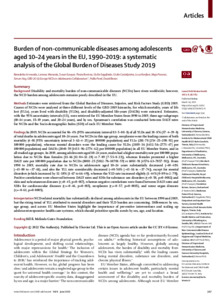ARMOCIDA, B, MONASTA, L, SAWYER, S, BUSTREO, F, SEGAFREDO, G, CASTELPIETRA, G, RONFANI, L, PASOVIC, M, HAY, S, SAWYER, SM, HAY, SI, ABILA, DB, ABOLHASSANI, H, ACCROMBESSI, MMK, ADEKANMBI, V, AHMADI, K, AL HAMAD, H, ALDEYAB, MA, AL-JUMAILY, A, ANCUCEANU, R, ANDREI, CL, ANDREI, T, ARUMUGAM, A, ATTIA, S, AUJAYEB, A, AUSLOOS, M, BAKER, JL, BARONE-ADESI, F, BARRA, F, BARTEIT, S, BASU, S, BAUNE, BT, BÉJOT, Y, BELO, L, BENNETT, DA, BIKBOV, B, BIKOV, A, BLYUSS, O, BREITNER, S, BRENNER, H, CARRERAS, G, CARVALHO, M, CATAPANO, AL, CHANDAN, JS, CHARALAMPOUS, P, CHEN, S, CONDE, J, CRUZ-MARTINS, N, DAMIANI, G, DASTIRIDOU, A, DE LA TORRE-LUQUE, A, DIANATINASAB, M, DIAS DA SILVA, D, DOUIRI, A, DRAGIOTI, E, ENGELBERT BAIN, L, FAGBAMIGBE, AF, FERESHTEHNEJAD, SM, FERRARA, P, FERREIRA DE OLIVEIRA, JMP, FERRERO, S, FERRO DESIDERI, L, FISCHER, F, FONSECA, DA, GAEWKHIEW, P, GAIHRE, S, GALLUS, S, GASPAR FONSECA, M, GILL, PS, GLASBEY, JC, GORINI, G, GUPTA, VK, GURARA, MK, HARO, JM, HASAN, MT, HAVMOELLER, RJ, HEIBATI, B, HELLEMONS, ME, HERTELIU, C, HUSSAIN, S, ISOLA, G, JOHNSON, O, JONAS, JB, JOZWIAK, JJ, JÜRISSON, M, KABIR, Z, KARCH, A, KAUPPILA, JH, KAYODE, GA, KHAN, MA, KHATAB, Khaled, KIVIMÄKI, M, KLUGAR, M, KLUGAROVÁ, J, KOLY, KN, KOYANAGI, A, KURMI, OP, KUSUMA, D, LA VECCHIA, C and LACEY, B
(2022).
Burden of non-communicable diseases among adolescents aged 10–24 years in the EU, 1990–2019: a systematic analysis of the Global Burden of Diseases Study 2019.
The Lancet Child and Adolescent Health, 6 (6), 367-383.
[Article]
Documents
30483:606380
![[thumbnail of Khatab-BurdenNon-communicable(VoR).pdf]](https://shura.shu.ac.uk/30483/1.hassmallThumbnailVersion/Khatab-BurdenNon-communicable%28VoR%29.pdf)

Preview
Abstract
Background: Disability and mortality burden of non-communicable diseases (NCDs) have risen worldwide; however, the NCD burden among adolescents remains poorly described in the EU. Methods: Estimates were retrieved from the Global Burden of Diseases, Injuries, and Risk Factors Study (GBD) 2019. Causes of NCDs were analysed at three different levels of the GBD 2019 hierarchy, for which mortality, years of life lost (YLLs), years lived with disability (YLDs), and disability-adjusted life-years (DALYs) were extracted. Estimates, with the 95% uncertainty intervals (UI), were retrieved for EU Member States from 1990 to 2019, three age subgroups (10–14 years, 15–19 years, and 20–24 years), and by sex. Spearman's correlation was conducted between DALY rates for NCDs and the Socio-demographic Index (SDI) of each EU Member State. Findings: In 2019, NCDs accounted for 86·4% (95% uncertainty interval 83·5–88·8) of all YLDs and 38·8% (37·4–39·8) of total deaths in adolescents aged 10–24 years. For NCDs in this age group, neoplasms were the leading causes of both mortality (4·01 [95% uncertainty interval 3·62–4·25] per 100 000 population) and YLLs (281·78 [254·25–298·92] per 100 000 population), whereas mental disorders were the leading cause for YLDs (2039·36 [1432·56–2773·47] per 100 000 population) and DALYs (2040·59 [1433·96–2774·62] per 100 000 population) in all EU Member States, and in all studied age groups. In 2019, among adolescents aged 10–24 years, males had a higher mortality rate per 100 000 population due to NCDs than females (11·66 [11·04–12·28] vs 7·89 [7·53–8·23]), whereas females presented a higher DALY rate per 100 000 population due to NCDs (8003·25 [5812·78–10 701·59] vs 6083·91 [4576·63–7857·92]). From 1990 to 2019, mortality rate due to NCDs in adolescents aged 10–24 years substantially decreased (–40·41% [–43·00 to –37·61), and also the YLL rate considerably decreased (–40·56% [–43·16 to –37·74]), except for mental disorders (which increased by 32·18% [1·67 to 66·49]), whereas the YLD rate increased slightly (1·44% [0·09 to 2·79]). Positive correlations were observed between DALY rates and SDIs for substance use disorders (rs=0·58, p=0·0012) and skin and subcutaneous diseases (rs=0·45, p=0·017), whereas negative correlations were found between DALY rates and SDIs for cardiovascular diseases (rs=–0·46, p=0·015), neoplasms (rs=–0·57, p=0·0015), and sense organ diseases (rs=–0·61, p=0·0005). Interpretation: NCD-related mortality has substantially declined among adolescents in the EU between 1990 and 2019, but the rising trend of YLL attributed to mental disorders and their YLD burden are concerning. Differences by sex, age group, and across EU Member States highlight the importance of preventive interventions and scaling up adolescent-responsive health-care systems, which should prioritise specific needs by sex, age, and location. Funding: Bill & Melinda Gates Foundation.
Actions (login required)
 |
View Item |



 Tools
Tools Tools
Tools